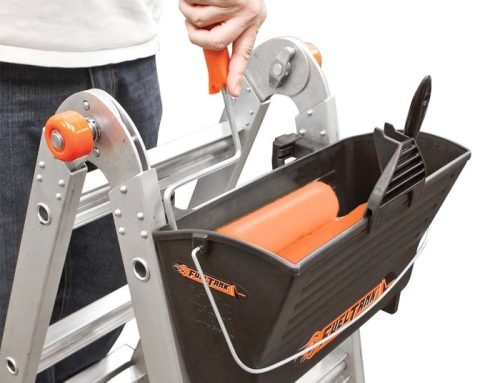Step ladder accidents can happen very easily in the home, probably because the step ladder is the most commonly used piece of access equipment inside the house. Step ladders are easy to store and transport around the home and because they are available in many different heights there is always one perfect for the job.
Using a step-ladder doesn’t need to be dangerous, as a few safety precautions and  sensible use of the equipment can prevent most accidents from happening. Stepladders should have four legs on the ground at all times, compared to two for a straight ladder. This means you need to be extra careful about the floor level on all sides of the step ladder, especially around doorways and any other transitions of floor surface. Some carpets can be at different heights than others, especially newly laid ones. Transitions between hard floor and thick carpet can present height differences that are very noticeable when you’re up a step ladder painting the door frame. If there are rugs or other moveable floor coverings, take these away before setting up the ladder as they present a slipping hazard.
sensible use of the equipment can prevent most accidents from happening. Stepladders should have four legs on the ground at all times, compared to two for a straight ladder. This means you need to be extra careful about the floor level on all sides of the step ladder, especially around doorways and any other transitions of floor surface. Some carpets can be at different heights than others, especially newly laid ones. Transitions between hard floor and thick carpet can present height differences that are very noticeable when you’re up a step ladder painting the door frame. If there are rugs or other moveable floor coverings, take these away before setting up the ladder as they present a slipping hazard.
Setting Up Your Step Ladder
Your step ladder should be set up with the legs fully open and the spreaders locked into place. Some stepladders, especially those with a platform, will feature a platform lock at the top to ensure the ladder is fully deployed. If the step ladder is not fully open it can slip or suddenly lock while in use, potentially throwing you off. Most step ladders have bracing legs at the back and these are not designed to be climbed, as any bars in between them are designed to support the structure of the stepladder, not a person’s weight. Some step-ladders are designed to be climbed from both sides, so while it’s fine to use this type from either side, never attempt it on a single sided step ladder.
 Always check the step ladder for signs of damage or oil before use, as cracked ladders or bent rungs significantly impact the rigidity of the ladder and can cause an accident. Oil or other slippery substances on the ladder can cause poor grip on the hands or feet, thereby increasing the risk of falling. When using the ladder sturdy, closed toe shoes are a must, as flimsy footwear can get caught in the ladder. Always check your laces are done up! Climb the ladder with your body centered between the side rails and do not reach outside this span to work. Instead, descend the ladder, move the step-ladder along, and ascend to begin working again. Over reaching can cause the step ladder to topple sideways, so even though moving the ladder a lot might seem inconvenient, think about how much more inconvenient broken ribs are.
Always check the step ladder for signs of damage or oil before use, as cracked ladders or bent rungs significantly impact the rigidity of the ladder and can cause an accident. Oil or other slippery substances on the ladder can cause poor grip on the hands or feet, thereby increasing the risk of falling. When using the ladder sturdy, closed toe shoes are a must, as flimsy footwear can get caught in the ladder. Always check your laces are done up! Climb the ladder with your body centered between the side rails and do not reach outside this span to work. Instead, descend the ladder, move the step-ladder along, and ascend to begin working again. Over reaching can cause the step ladder to topple sideways, so even though moving the ladder a lot might seem inconvenient, think about how much more inconvenient broken ribs are.
The top rung of a step-ladder should never be used to stand on. Most step ladders are labeled to show which rung is the highest you can safely stand on, so when you are choosing the right step ladder for the job, make sure you compare the working reaches of the ladder rather than the top rung height, as these are two completely different heights in practice. The step ladder should be set up directly in front of the working area, not side-on or diagonally. This is to ensure your weight is not twisted and that you are firmly on the ladder while carrying out your task. Approaching it at a different angle increases the risk of falling from the step-ladder. Some step ladders are designed to have telescopically adjustable back legs, allowing you to set it up almost flush against a wall.
If you follow these tips and go carefully, you should avoid most of the common causes of step ladder accidents, and get all your decorating, cleaning or maintenance done safely.






Leave A Comment
You must be logged in to post a comment.